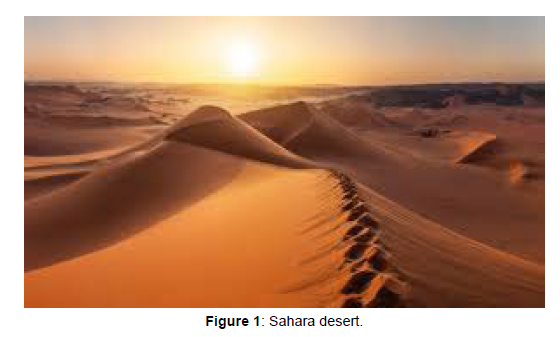Safeguarding the Sahara Desert: Conservation in Earth's Largest Hot Desert
Received: 03-Aug-2023 / Manuscript No. JEE-23-109451 / Editor assigned: 05-Aug-2023 / PreQC No. JEE-23-109451 (PQ) / Reviewed: 19-Aug-2023 / QC No. JEE-23-109451 / Revised: 22-Aug-2023 / Manuscript No. JEE-23-109451 (R) / Published Date: 29-Aug-2023 DOI: 10.4172/2157-7625.1000432
Abstract
The Sahara Desert, an awe-inspiring expanse of sand and sun, is the world's largest hot desert and a mesmerizing testament to the forces of nature. While often associated with harsh conditions and uninhabitable landscapes, the Sahara is a fragile ecosystem teeming with unique flora and fauna. However, this delicate desert ecosystem is facing significant threats due to human activities and climate change. Conservation efforts in the Sahara are essential to preserve its biodiversity and ecological balance.
Keywords
Sahara desert; Conservation; Earth
Introduction
Covering over 9.2 million square kilometers across North Africa, the Sahara Desert is a land of diverse landscapes, ranging from vast sand dunes to rocky plateaus and oases. It is home to a surprising array of life, including hardy plant species, insects, reptiles, and even some mammals uniquely adapted to the harsh conditions [1,2].
Methodology
Challenges to Sahara's biodiversity
The Sahara Desert faces numerous challenges that threaten its delicate balance:
Overgrazing and desertification: Uncontrolled grazing by livestock and unsustainable agricultural practices accelerate desertification, converting once fertile lands into barren desert [3].
Human settlements and infrastructure: The establishment of human settlements, roads, and infrastructure in the desert disturbs local habitats, leading to habitat loss and fragmentation.
Climate change: Rising temperatures and changing rainfall patterns due to climate change have the potential to alter the Sahara's ecosystems, affecting plant growth and animal behaviour [4, 6].
Illegal wildlife trade: Some desert species, like the Saharan cheetah and dama gazelle, are hunted and captured for the illegal wildlife trade, threatening their survival (Figure 1).
Conservation strategies for the Sahara
Preserving the biodiversity and ecological integrity of the Sahara Desert requires a multi-faceted approach:
Protected areas: Establishing and maintaining protected areas and nature reserves is crucial to safeguarding key habitats and providing refuge for endangered species.
Sustainable land use: Encouraging sustainable land use practices, such as controlled grazing and reforestation, can combat desertification and restore degraded lands [7-9].
Community involvement: Involving local communities in conservation efforts fosters a sense of stewardship and ensures that conservation initiatives align with the needs and values of the people living in the region.
Climate change mitigation: Global efforts to mitigate climate change are essential for preserving the Sahara's ecosystems and preventing further degradation.
Anti-poaching and law enforcement: Strengthening antipoaching measures and enforcing wildlife protection laws are vital to combat the illegal wildlife trade and protect vulnerable species.
The promise of conservation
Conserving the Sahara Desert is not just about preserving a remarkable landscape; it is about protecting Earth's biodiversity and securing the well-being of the communities living in and around the desert. A balanced and healthy Sahara ecosystem offers crucial ecosystem services, including soil stabilization, water retention, and climate regulation [10].
Conclusion
The Sahara Desert, with its unparalleled beauty and resilience, is a testament to the wonders of our planet. However, the delicate balance of this unique ecosystem is under threat from human activities and climate change. Conservation efforts in the Sahara are essential to preserve its biodiversity, protect endangered species, and ensure the sustainability of this iconic desert landscape.
As we embark on the journey of conserving the Sahara, we must remember that the desert's survival is intricately linked to the well-being of our entire planet. By valuing and protecting this precious ecosystem, we embrace our responsibility as stewards of the Earth, ensuring that future generations can marvel at the beauty and magnificence of the Sahara Desert for years to come.
References
- Granados JAT, Ionides EL, Carpintero O (2012) Climate change and the world economy: short-run determinants of atmospheric CO2. Environ Sci Pol 21: 50-62.
- Murray J, King D (2012) Climate policy: oil's tipping point has passed. Nature 481: 433.
- Beni AN, Marriner N, Sharifi A, Azizpour J, Kabiri K, et al. (2021) Climate change: A driver of future conflicts in the Persian Gulf Region.
- Zenghelis D (2006) Stern Review: the Economics of Climate Change. HM Treasury, London, England.
- Van Lavieren H, Burt J, Cavalcante G, Marquis E, Benedetti L, et al. (2011) Managing the Growing Impacts of Development on Fragile Coastal and Marine Ecosystems: Lessons from the Gulf. UNU-INWEH, Hamilton, ON, Canada.
- Burt JA, Paparella F, Al-Mansoori N, Al-Mansoori A, Al-Jailani H (2019) Causes and consequences of the 2017 coral bleaching event in the southern Persian/Arabian Gulf. Coral Reefs 38: 567-589.
- UNDP (2010) Mapping of Climate Change Threats and Human Development Impacts in the Arab Region. United Nations Development Programme, Regional Bureau for Arab States, Arab Human Development Report, UNDP.
- Alothman A, Bos M, Fernandes R, Ayhan M (2014) Sea level rise in the north-western part of the Arabian Gulf. J Geodyn 81: 105-110.
- Mathers E L, Woodworth PL (2004) A study of departures from the inverse-barometer response of sea level to air-pressure forcing at a period of 5 days.QJR Meteorol Soc 130: 725-738.
- Gurevich AE, Chilingarian GV (1993) Subsidence over producing oil and gas fields, and gas leakage to the surface. J Pet Sci Eng 9: 239-250.
Indexed at, Google Scholar, Crossref
Indexed at, Google Scholar, Crossref
Indexed at, Google Scholar, Crossref
Indexed at, Google Scholar, Crossref
Indexed at, Google Scholar, Crossref
Indexed at, Google Scholar, Crossref
Citation: James S (2023) Safeguarding the Sahara Desert: Conservation inEarth's Largest Hot Desert. J Ecosys Ecograph, 13: 432. DOI: 10.4172/2157-7625.1000432
Copyright: © 2023 James S. This is an open-access article distributed under theterms of the Creative Commons Attribution License, which permits unrestricteduse, distribution, and reproduction in any medium, provided the original author andsource are credited.
Share This Article
Recommended Journals
Open Access Journals
Article Tools
Article Usage
- Total views: 2794
- [From(publication date): 0-2023 - Mar 29, 2025]
- Breakdown by view type
- HTML page views: 2555
- PDF downloads: 239

